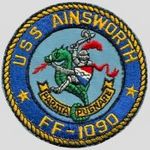AINSWORTH FFT 1090
Ship Name and Designation History
This section lists the names and designations that the ship had during its lifetime. The list is in chronological order.
This section lists active links to the pages displaying covers associated with the ship. There should be a separate set of pages for each incarnation of the ship (ie, for each entry in the "Ship Name and Designation History" section). Covers should be presented in chronological order (or as best as can be determined).
Since a ship may have many covers, they may be split among many pages so it doesn't take forever for the pages to load. Each page link should be accompanied by a date range for covers on that page.
Postmarks
This section lists examples of the postmarks used by the ship. There should be a separate set of postmarks for each incarnation of the ship (ie, for each entry in the "Ship Name and Designation History" section). Within each set, the postmarks should be listed in order of their classification type. If more than one postmark has the same classification, then they should be further sorted by date of earliest known usage.
A postmark should not be included unless accompanied by a close-up image and/or an
image of a cover showing that postmark. Date ranges MUST be based ONLY ON COVERS IN
THE MUSEUM and are expected to change as more covers are added.
>>> If you have a better example for any of the postmarks, please feel free to replace the
existing example.
|
Postmark Type |
Date From to Date To |
Thumbnail Link To Postmark Image |
Thumbnail Link To Cover Image |
|---|
Post Office Established March 31 1973 - Disestablished May 27 1994
|
Locy Type |
1973-03-31 |
 |
 |
Notes: Contributed by Jennifer Hoffman.
|
Locy Type |
1973-05-29 |
 |
 |
As DE-1090
|
Locy Type |
1975-06-30 |
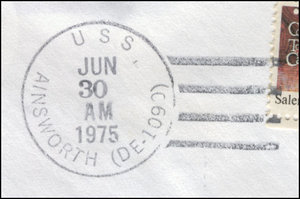 |
 |
As DE-1090
Last Day Hull Designation. Cachet by Richard F. Hoffner, sponsored by Stephen Decatur Chapter No. 4, USCS
|
Locy Type |
1976-06-01 |
 |
 |
As FF-1090, (Still using DE marking)
Welcome to the US, Netherlands Naval visit, cachet by Tazewell G. Nicholson
|
Locy Type |
1978-04-18 |
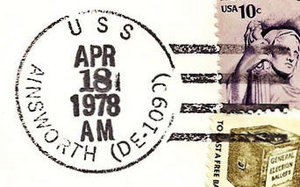 |
 |
As FF-1090, (Still using DE marking)
Welcome to the US, HMCS PORTE DAUPHINE visit, cachet by Tazewell G. Nicholson
|
Locy Type |
1979-06-11 |
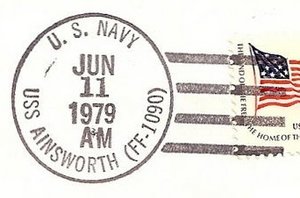 |
 |
As FF-1090
|
Locy Type |
1989-07-04 |
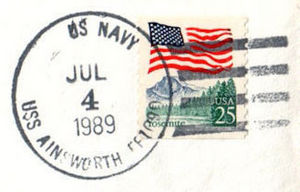 |
 |
FF-1090. Independence Day, cachet by Gary R. Rogak
|
Locy Type |
1993-11-28 |
 |
 |
As FFT-1090
|
Locy Type |
1978-04-17
|
 |
 |
As FF-1090 still using DE strike
|
Locy Type |
1980-05-20 |
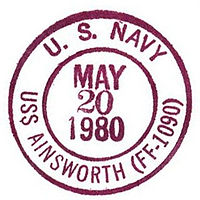 |
 |
As FF-1090
|
Locy Type P |
1978-05-28 |
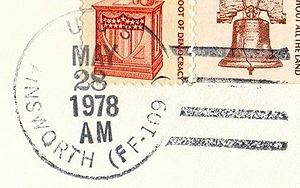 |
 |
As FF-1090
|
Locy Type |
1994-05-27 |
 |
 |
As FFT-1090
Last Day of Commissioning. Cachet by Al Banasky
|
Locy Type |
1994-05-27 |
 |
 |
As FFT-1090
Last Day of Commissioning. Cachet by Al Banasky
Other Information
USS AINSWORTH earned the Joint Meritorious Unit Award Ribbon, the Navy Unit Commendation Ribbon, the Navy Battle "E" Ribbon, the Navy Expeditionary Medal w/ 2 bronze stars, the National Defense Service Medal w/ 1 bronze star, the Sea Service Deployment Ribbon and the Coast Guard Special Operations Service Ribbon during her Naval career.
NAMESAKE - Vice Admiral Walden Lee Ainsworth, USN (November 10 1886 - August 7 1960)
Ainsworth entered The Naval Academy on June 21 1906 and graduated on June 3 1910. Following successive two-year tours at sea in USS IOWA BB-4 and in transport USS PRAIRIE he shifted to USS FLORIDA BB-30 during the spring of 1914, just in time to act as the adjutant of one of the battalions that landed at Veracruz, Mexico, on April 21. Upon the successful completion of that operation, he returned to USS FLORIDA and served in her until sent to USS DE KALB SP-3010 in May 1917. During the participation of The United States in World War I, he served in transports DE KALB and in USS AMERICA TT-3006. During the last months of the conflict, he found himself in USS FREDERICK CA-8. In February 1919, the young officer went to Charles Town, W. Va., for two years as inspector of ordnance at the Navy's Armor and Projectile Plant before returning to sea as Executive Officer of the transport USS HANCOCK AP-3. Then, after a brief stint holding the same post in the light cruiser USS BIRMINGHAM CL-2, he commanded the destroyer USS MARCUS DD-321 for a year before becoming inspector of ordnance at Pittsburgh. In August 1924, orders sent him to the New York Navy Yard. By the end of 1925, Ainsworth's growing stature in the field of ordnance won him the position of gunnery officer on the staff of the Commander, Destroyer Squadrons, Asiatic Fleet. In July 1927, he took command of PAUL JONES DD-230, but left that destroyer late in the summer of 1928 to begin three years at the Naval Academy as an instructor in the Department of Navigation. At the end of the 1930-31 academic year, Ainsworth returned to sea in USS IDAHO BB-42 to serve as that battleship's navigator. Next came a tour in heavy cruiser USS PENSACOLA CA-24 and one as communication officer for the 14th Naval District before he reported to the Naval War College at Newport, R.I., for the senior course. In June 1936, Ainsworth became the Executive Officer of USS MISSISSIPPI BB-41 and, two years later, he became Professor of Naval Science and Tactics at Tulane University in New Orleans. World War II in Europe was almost a year old when he took command of Destroyer Squadron 2 on July 22 1940, and The United States had just entered that conflict when he returned to USS MISSISSIPPI as her Commanding Officer on December 19 1941. Ainsworth promptly took that veteran battleship to the Pacific to strengthen the Navy's surface force in that ocean which had been seriously weakened by the Japanese surprise attack on Pearl Harbor. On July 4 1942, Ainsworth took administrative command of all Pacific Fleet destroyers. On December 10 of that year, Admiral Halsey gave him the additional duty of commanding Task Force (TF) 67 which had been badly mauled in the recent Battle of Tassafaronga; and, under his leadership that cruiser destroyer force was soon winning renown as the "Ainsworth Express" for its fierce fighting in support of the final American drive to push Japanese troops off Guadalcanal. Its bombardment of the new Japanese air base at Munda on the island of New Georgia would be, in the words of naval historian, Samuel Eliot Morison, "... long regarded as a model . . . ." Transferred to command of TF 18 and Cruiser Division 9, Ainsworth continued his success during a prolonged series of runs up the long, narrow body of water between the central Solomon Islands which American bluejackets had nicknamed "the Slot." These operations parried the thrusts by Japanese warships challenging Allied control of the area. At the end of June, the tempo of American fighting in the southwestern Pacific picked up since the Navy had finally managed to assemble enough amphibious shipping in that theatre to resume the offensive. On the night of July 4 and 5, TF 18 moved up "the Slot" and bombarded Japanese positions at Vila on Kolombangara and at Baiko on New Georgia. The next afternoon, while Ainsworth's force was retiring from this action, word reached him that a large Japanese force was heading toward "the Slot." In an effort to meet and check this new threat, his warships again reversed course and headed toward the enemy. Ainsworth's ". . . outstanding leadership, brilliant tactics and courageous conduct . . ."in the ensuing battle of Kula Gulf earned him a Navy Cross. He also received the Distinguished Service Medal for his overall performance in the southwestern Pacific. About a year later, Ainsworth received the Legion of Merit Medal by his ". . . exceptionally meritorious conduct ..." while commanding the fire support group during operations which recaptured Guam. Finally, he received a gold star in lieu of a second Legion of Merit for his display of ". . . exceptional ability and aggressiveness in handling the organization and administration of the cruisers, destroyers, destroyer escorts, and patrol frigates of the Pacific Fleet." After returning to the United States in the summer of 1945, Vice Admiral Ainsworth commanded the Fifth Naval District until retiring on December 1 1948. He died in Washington, D.C., on August 7 1960.
The ships sponsor was Mrs. Katherine Gardner Ainsworth, the widow of Vice Admiral Ainsworth.
If you have images or information to add to this page, then either contact the Curator or edit this page yourself and add it. See Editing Ship Pages for detailed information on editing this page.
Copyright 2024 Naval Cover Museum

